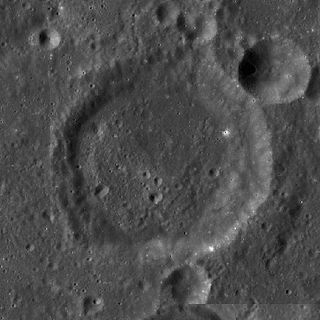
Almanon is a lunar impact crater that lies in the rugged highlands in the south-central region of the Moon. It was named after Abbasid Caliph and astronomer Al-Ma'mun. It is located to the south-southeast of Abulfeda, and to the north-northeast of the smaller crater Geber. The crater chain designated Catena Abulfeda forms a line between the south rim of Abulfeda and the north rim of Almanon, continuing for a length of about 210 kilometers to the Rupes Altai scarp.

Appleton is a heavily eroded lunar impact crater that lies in the northern hemisphere on the far side of the Moon. To the northwest are the craters Von Neumann and Campbel. The smaller Golovin lies to the northeast, while further to the southwest is the Mare Moscoviense.

Armiński is a small lunar impact crater that is located on the far side of the Moon, to the northeast of the large walled basin Gagarin. To the northwest of Armiński is the crater Beijerinck, and to the southeast lies Cyrano.
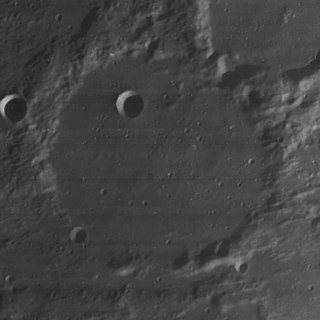
Arnold is a lunar impact crater that is located in the north-northeastern part of the visible Moon, near the lunar limb. This location gives the crater a notably oval appearance due to foreshortening, although the formation is actually relatively round. It lies to the northeast of the Mare Frigoris, to the north of the crater Democritus. West of Arnold is the smaller crater Moigno.

Baillaud is a lunar impact crater that is located near the north limb of the Moon. The rim of the crater has been eroded and worn by a long history of impacts, leaving a hilly ridge surrounding the interior. The crater Euctemon is intruding into the rim to the northeast, and the rim bulges outward to the northwest. At the south end of the crater is a gap connecting to the lava-flooded surface to the south.

Barrow is an old lunar impact crater that is located near the northern limb of the Moon. It lies between the crater Goldschmidt to the northwest and the irregular formation Meton to the northeast. To the southwest is W. Bond.

Bergstrand is a lunar impact crater that lies on the far side of the Moon. It is located just to the southeast of the prominent crater Aitken, and northeast of the walled plain Vertregt.

Goddard is a lunar impact crater that is located along the eastern limb of the Moon, and so is visible from the edge from Earth. It is best viewed during favorable librations when the orientation of the Moon brings it further into sight. The crater is located in the Mare Marginis, to the northeast of the prominent crater Neper. Ibn Yunus, a crater remnant, is attached to the southeastern rim and is partly overlaid by Goddard. To the northeast is Al-Biruni.

Boole is a lunar impact crater that lies along the northwestern limb of the Moon, to the northwest of the crater Gerard. At this location it is viewed nearly from the side, and is very oblong in shape due to foreshortening. The crater formation is nearly circular, however, with a wide inner wall that has been worn and rounded due to subsequent impacts. It is named after George Boole.

Biela is a lunar impact crater that is located in the rugged highlands of the southeastern Moon. It is named after Austrian astronomer Wilhelm von Biela. The crater lies to the east of Rosenberger, to the southeast of the Watt–Steinheil double crater.

Bobone is an old, heavily eroded crater formation that lies on the far side of the Moon. Little remains of the original crater formation, leaving only a bowl-shaped depression in the surface that is pock-marked by tiny craterlets. It is attached to the southwest rim of the large satellite crater Kovalevskaya Q, which has its northeast rim overlaid by Kovalevskaya itself. To the west-southwest is Bronk.
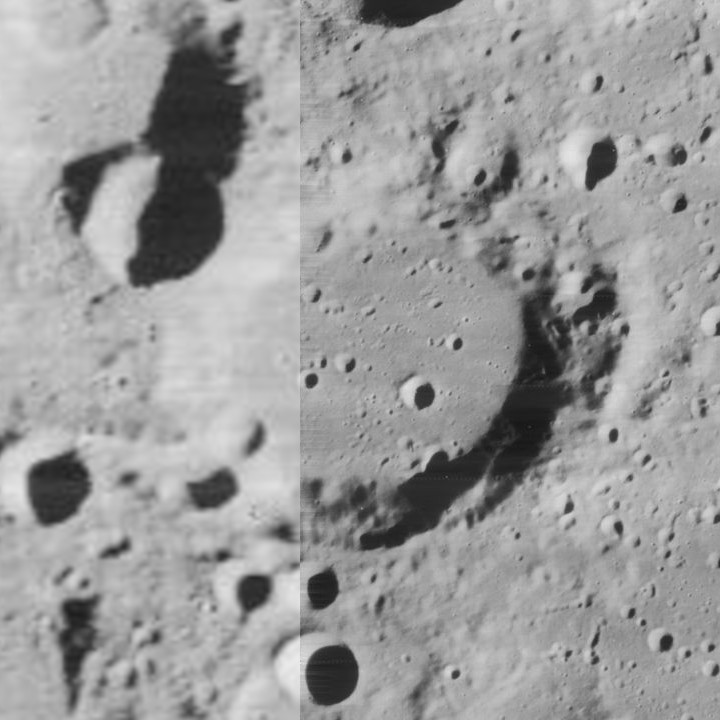
Cleostratus is a lunar impact crater near the northwest limb of the Moon. It lies to the northeast of the crater Xenophanes, and west-southwest of the prominent Pythagoras. From the Earth this crater appears highly elongated due to foreshortening.
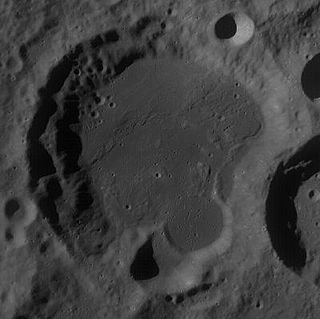
Crocco is a lunar impact crater that is located on the far side of the Moon from the Earth. It is located to the northeast of the huge walled plain Planck, and northwest of the equally huge Poincaré. Just to the north, within one crater diameter, is the crater Koch.
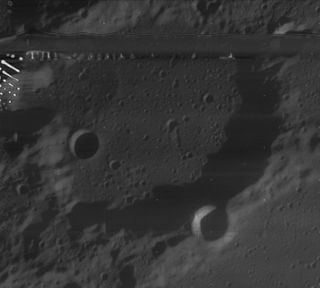
Euctemon is a lunar impact crater that is located in the northern part of the Moon, along the northwest rim of the crater Baillaud. To the southwest of Euctemon is the large walled plain Meton, and to the north-northeast lies the crater De Sitter. Due to its location, Euctemon appears foreshortened when viewed from the Earth.

Faye is a heavily eroded lunar impact crater in the rugged southern highlands of the Moon. It is named after French astronomer Hervé Faye. It is attached to the northeastern rim of the crater Delaunay, with Donati located just a few kilometers to the northeast. It forms part of a chain of craters of increasing size to the southwest that continues with La Caille and ends with the walled plain Purbach.

Fraunhofer is a lunar impact crater that is located just to the south-southwest of the walled plain Furnerius, in the southeastern part of the Moon. This crater appears foreshortened when viewed from the Earth, and is actually nearly circular.

Esnault-Pelterie is a lunar impact crater on the far side of the Moon, named after French rocketry and astronautics pioneer Robert Esnault-Pelterie. It is located in the northern hemisphere, to the south of the crater Carnot. Esnault-Pelterie overlies the western side of the crater Schlesinger. To the south is the crater Von Zeipel and to the southwest is Fowler.

Evershed is a lunar impact crater on the far side of the Moon, named after the English solar astronomer John Evershed. It is located to the northeast of the larger crater Cockcroft, and to the north of the smaller Van den Bergh.

Volkov is a lunar impact crater on the Moon's far side. It is located to the north of the prominent crater Tsiolkovskiy, and east-southeast of Dobrovol'skiy. Overlying the southeastern rim of Volkov is the satellite crater Volkov J, and the two have merged to form a figure-8 shape. The crater Lander is attached to the southwest rim of Volkov J, making this a triple-crater formation.

Parkhurst is a heavily degraded lunar impact crater to the northeast of the Mare Australe on the far side of the Moon. To the north-northeast of Parkhurst is the crater Scaliger and to the southwest lies the dark-floored Gernsback. The small lunar mare named Lacus Solitudinis lies due north of Parkhurst.






















